This instalment of women whose science fiction writing careers began in the 1970s is brought to you by “letters that begin the surnames of women writers” (letters which are, of course, unevenly distributed) and covers women whose surnames begin with the letters R and S.
Previous instalments in this series cover women writers with last names beginning with A through F, those beginning with G, those beginning with H, those beginning with I & J, those beginning with K, those beginning with L, those beginning with M, and those beginning with N, O, and P.
Marta Randall
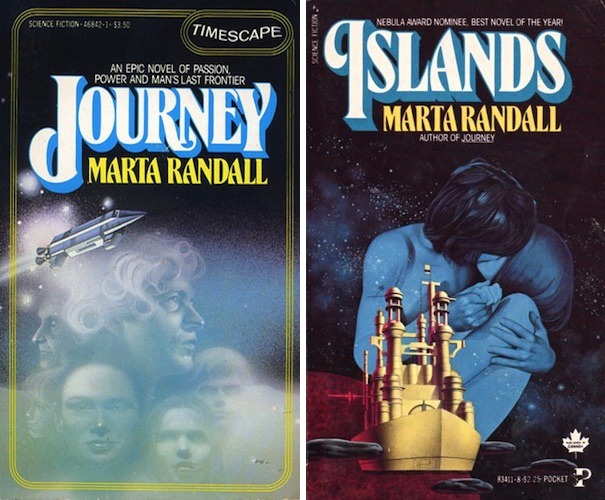
Born in Mexico, now resident in Hawaii1, these days Marta Randall focuses on short pieces. Between the late 1970s and the early 1990s, she published seven novels. Her Kennerin series, a family saga set on an alien world shared (sometimes uncomfortably) with its intelligent natives, may be her best-known work. Readers new to her fiction might try Randall’s standalone novel Islands, in which a mortal woman in a world of the ageless uses archaeology to come to terms with her condition.
Anne Rice
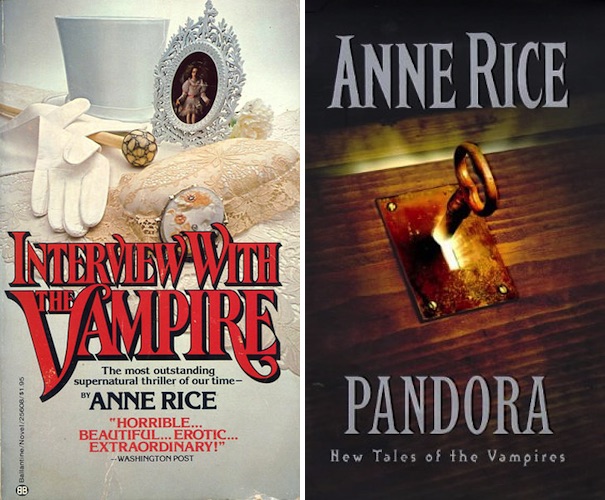
Anne Rice is a prolific and often colourful author with legions of loyal and easily energized fans on social media. Her disinclination to permit editors to tamper with her prose makes her later work…memorable. I would recommend starting with her debut horror novel Interview With The Vampire, which delivers exactly what it says on the label. Quite remarkably, the publishers of Interview decided that it warranted television ads, something I don’t recall seeing for books before or since. Though we do have internet book trailers now…
Jessica Amanda Salmonson
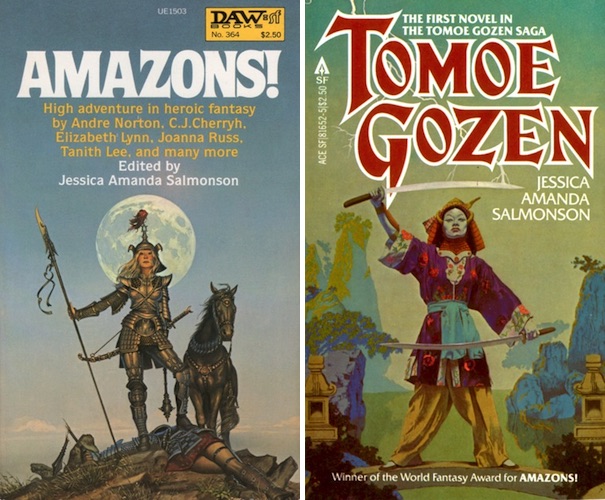
Jessica Amanda Salmonson is active as a writer and editor, as well as a reviewer. I am honestly torn which of two obvious choices to recommend.
A: 1981’s Tomoe Gozen (later revised under the title The Disfavoured Hero), which merges the life of a woman samurai warrior with fantastic elements drawn from Japanese myth.
B: the World Fantasy Award-winning 1979 anthology Amazons!, which was unusual for its day for its focus on women protagonists.
The Disfavored Hero is at least in print. On the other hand, print runs in the 1970s were large enough that it should be relatively easy to find a used copy of Amazons!
Pamela Sargent
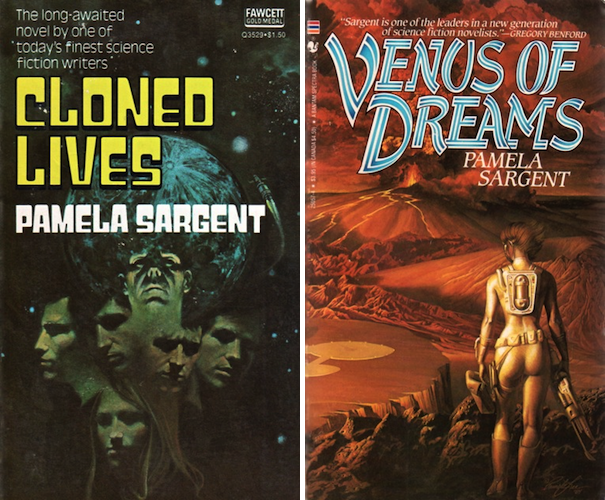
Pamela Sargent first caught my eye with 1976’s Cloned Lives, which takes a refreshingly mundane look at the lives of the world’s first clones. Their unusual parentage does not confer on them any particular special abilities like telepathy or telekinesis. Her Venus terraforming epic (Venus of Dreams, Venus of Shadows, and Child of Venus) may have been denied its proper place in the public psyche due to a somewhat troubled publication history; all three are in print and worth consideration. Also of interest is Sargent’s Women of Wonder series (Women of Wonder, More Women of Wonder, and The New Women of Wonder, followed in the 1990s by Women of Wonder: The Classic Years, and Women of Wonder: The Contemporary Years). The difficulty of tracking down the rights at this late date probably precludes reprints, but used copies are easily obtained.
Susan Shwartz
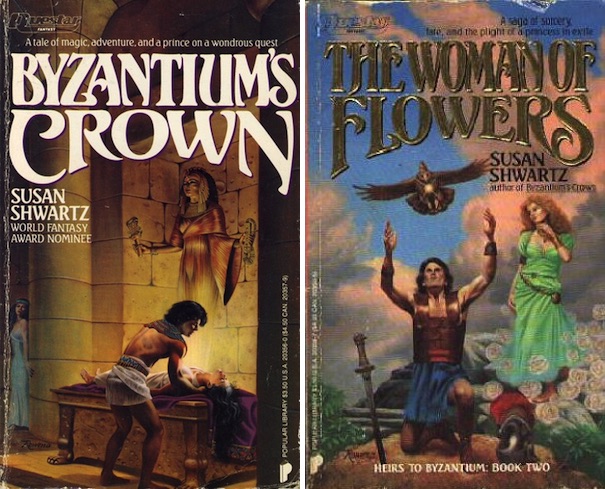
Susan Shwartz played an indirect role in inspiring this series2, despite which I am shockingly poorly read in her works. I have read and would recommend her Heirs to Byzantium series (Byzantium’s Crown (1987), The Woman of Flowers (1987), and Queensblade (1988)), in which Anthony and Cleopatra’s survival has rather dramatic effect on subsequent history.
Angela Sommer-Bodenburg
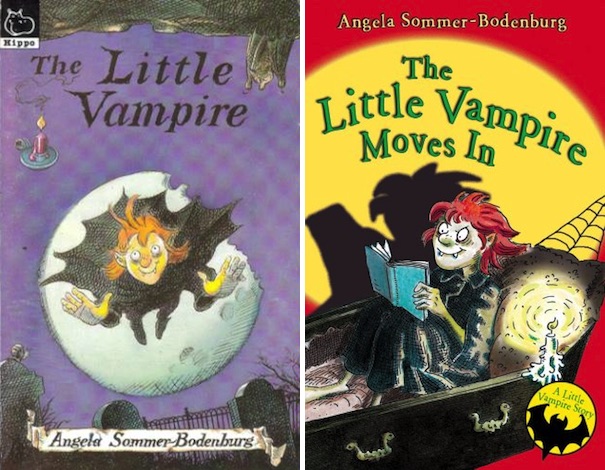
Angela Sommer-Bodenburg, first published in German, is the author of the highly successful Little Vampire series, whose lead character is considerably less of a monster than is typical for the undead. (Though I should note that The Little Vampire series is only a small fraction of her work.) If you (like me) cannot read German, the Little Vampires books have been translated into English. Fans may want to track down the recent animated adaptation, The Little Vampire 3D. It features Jim Carter as antagonist Rookery, which may interest any of you who might have wondered how the Downton Abbey character Charles Carson would have faired as a vampire hunter.
Nancy Springer
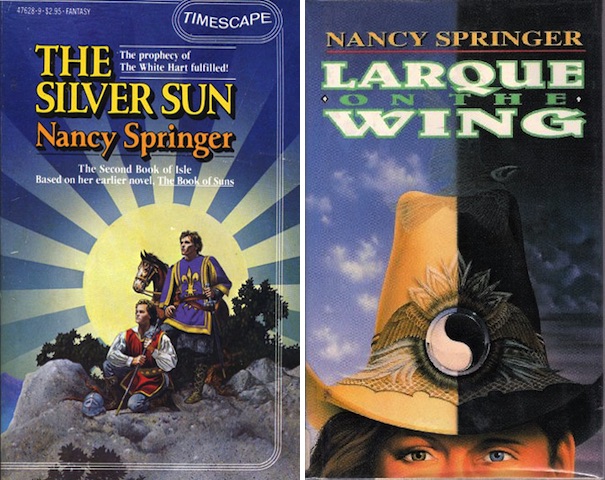
Nancy Springer is prolific and active across a range of genres, from fantasy to mystery. When sampling multi-genre authors like Springer, you might want to consult their award lists. If you’re a mystery fan, you could try her Edgar-winning Looking for Jamie Bridger or Toughing It. If you enjoy fantasy, consider Springer’s Tiptree-winner, Larque on the Wing. If you fancy novels nominated for now-incredibly-obscure awards, try Springer’s The Book of Suns. That was up for the Balrog3 (but you’ll probably prefer the revised edition, published as The Silver Sun).
Mary Stewart
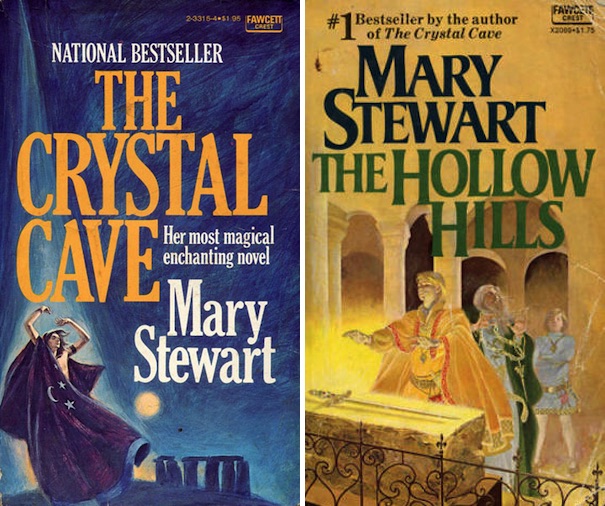
I was surprised to read (in a recent Facebook thread I have now misplaced) that Mary Stewart is now seen as a Young Adult writer. Hmmm. She was active in romantic mystery and historical genres, but the series by means of which persons of a certain age first encountered her was her five-volume Merlin series, which was comprised of the original three books (The Crystal Cave, The Hollow Hills, and The Last Enchantment) and two follow-up works (The Wicked Day, and The Prince and the Pilgrim). The original trio are a retelling of the Matter of Britain from Merlin’s perspective. I believe that they shaped a specific demographic’s view of Arthurian legend, just as Rosemary Sutcliff’s exemplary The Lantern Bearers did for earlier readers.
* * *
As usual, I’ve managed to miss the work of a number of women whose careers began in the 1970s. Pointers on where to begin with them welcome.
- Deborah K. Raney
- Kathryn Rantala
- Melanie Rawls
- L.P. Reeves
- Linda Richardson
- Fay Sampson
- Mary H. Schaub
- Anne Schraff
- Pamela F. Service
- A.E. Silas
- Gloria Skurzynski
- Kathleen Sky
- Kay Nolte Smith
- Petrina Smith
- Stephanie Stearns
Buy the Book


Worlds Seen in Passing: Ten Years of Tor.com Short Fiction
1: On the largest Hawaiian island, home of the volcano goddess Pele. Although my great-grandfather made his home on Maui (whose volcanoes are sadly defunct), he and his chums made their way to the Big Island, where they had jolly fun tramping around on the recently solidified lava in Kīlauea Caldera during one of its exuberant periods. The only minor drawback was that because it was hard to tell solid lava from liquid with a thin crust, “One had to keep constantly on the move to save the shoes from burning.” The moral here is that like bears and typhoons, volcanoes are our friends.
2: Because in the course of a discussion my attempt to document that she had been active in SF since the 1970s led me to discover this article of hers, which among other things documents the backlash against women SF authors in the early 1980s.
3: The coveted Balrog Awards ran from 1979 to 1985. While the award may not be well known today, readers interested in works of the era could do much worse than to peruse the nominee lists for potential reads. The Balrogs should not be confused with Gandalf Awards, which were conferred by the World Science Fiction Society (at the behest of the Swordsmen and Sorcerers’ Guild of America4) from 1974 to 1981. There is room in this world for many long-forgotten awards named for figures from Lord of the Rings. How easy it is to create a new award! How hard to sustain it for decades!
4: Swordsmen and Sorcerers’ Guild of America was also known as SAGA. Why not SASGOA or SSGA, I cannot say.
In the words of Wikipedia editor TexasAndroid, prolific book reviewer and perennial Darwin Award nominee James Davis Nicoll is of “questionable notability.” His work has appeared in Publishers Weekly and Romantic Times as well as on his own websites, James Nicoll Reviewsand Young People Read Old SFF (where he is assisted by editor Karen Lofstrom and web person Adrienne L. Travis). He is surprisingly flammable.










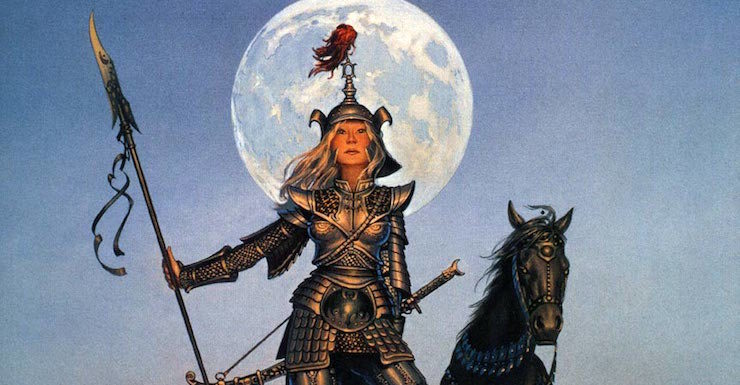
I am honestly surprised that Mary Stewart’s Arthur books didn’t start coming out until 1970 — for whatever reason, I had it in my head that they were a decade or two older than that.
As to why SAGA instead of SSGA or some such, the answer is obviously: Because Lin Carter.
Pamela Service was one of my favorite authors as a pre-teen. She wrote middle grade sci if, which seems to be a relatively dead genre now (I was introduced to Service and HM Hoover at the same time). She’s probably best know for the humorous Stinker From Space, which is great, but I also love A Question of Destiny and Being of Two Minds
I was a little surprised to see Mary Stewart here, since she was a well-established novelist by the early 60s. Is it just because her first genre work was 1970? In any case, she definitely shaped my view of Arthurian legend and probably started my interest in the late western Roman Empire as well. I also didn’t know there was a fifth book (apparently something cut from one of the earlier novels).
I read the Little Vampire books (in German) as a kid and watched the TV series.
I have to admit, those “Little Vampire” covers kind of creep me out a little bit.
Children’s book’s cover seemingly designed to traumatize children or at least their parents is a different essay series. But first I need to right Damn Straight I’m Still Angry About The Time My Kindergarten Showed a Double Bill Consisting of Old Yeller and The Red Balloon.
What sadists! I read Old Yeller in elementary school and ever after refused to read any book about an animal unkess assured it lived .
Isn’t there a website devoted to telling people if the pets in various books make it to the end of the book?
Although I don’t remember anyone in my family liking the movie, we named one of our dogs Yeller. He did not make it to old age. We also named a dog Blue. Who died exactly the way the dog in the song died. So we named the next dog Blue as well. When the second Blue died, by drowning, we named yet a third dog Blue. Due to certain disciplinary issues, Blue III may have been named Blue but he got called Pooper and lived to a reasonable age. The lesson here is “never name a pet something you don’t want to shout off the back porch.”
The Prince and the Pilgrim! I did not know this book existed (I read the Merlin series because my mother had copies – and either I left home before the last one came out, or she never got the last one).
@8 A friend named her dog Heathcliff just so she could shout it at night. (WUTHERING HEIGHTS, not the cat cartoon.)
I can deal emotionally with almost any horror in fiction as long as it doesn’t involve a pet or a small child. Family members fussed at me when I mentioned an animal’s fate in Will Smith’s version of LEGEND, but I thought I’d want to know before seeing the dang movie.
FWIW, there are still the occasional book commercials. The last that I can recall are from a couple years ago for James Patterson’s “Bookshots” series, which seemed to make the odd claim of inventing the novella.
I definitel recommend the Tomoe Gozen books.
@8 — http://www.doesthedogdie.com, which covers multiple potential issues across movies, TV, books and games.
Know why my sister is out of my.will? She told me how Old Yeller ended when I was halfway through.
Thanks again for this fine series. I’m happy to have read nearly all of the women listed and still proudly own two volumes of Amazons! They were really eye-opening for the suburban teenager that I was.
Thanks also for the footnotes. The Schwartz article is excellent, and makes points that still, sadly, ring true.
Man, I loved the Whelan covers. What happens to the original after the book is printed? Do publishers have galleries or something?
Speaking of “Old Yeller'”, I’ve always wondered at the thinking behind this. (An actual photo from a visit to Utah a few years back.)
@13
I call your sister lucky for not getting what the dog got.
I expect Whelan gets his originals back. At least, he seems to have originals for sale on his site.
http://www.michaelwhelan.com/shop/original-art/
For “feminist SF writers who wrote particularly influential works in the 1970s”, there’s Joanna Russ. “When It Changed” 1972 or so
This is women who debuted in the 1970s, not ones who were influential. On the minus side, it means I don’t get to talk about women like Le Guin, Russ, Merril, and Bracket. On the plus side, I can side-step the whole MZB issue for the moment.
There is a fifth Stewart!Merlin book?!
haha, MZB. She had way too much shelf space back in the day.
@@@@@#20, re MZB
Well, she started out writing really good books about Threadfall. They were even SF, sort-of. And she wrote a few other Real SF books, if memory serves. Darkover Landfall (1972). Fond memories of that one. Pretty sure I still have a copy around, somewhere…. The cover of the SFBC ed is *Wonderful*:
Then… Well. She got a castle in Ireland out of the schlocky ones, right.? Is she still with us? Huh, dead almost 20 years! Shows you how well I keep up:
https://en.wikipedia.org/wiki/Marion_Zimmer_Bradley
Kathleen Sky wrote Witchdame, which I adored so much I spent years trying to find anything else by her. Nice medieval fantasy with sex magic, angels, and family dynamics. I think I read somewhere that she had health issues while writing Witchdame, and I was afraid she might not be writing anymore. Thanks to the internet I see this is not the case!
@22 – Yes! Another Witchdame fan! I read that book obsessively as a youth. It’s … got some pretty weird bits when you reread it as a grown, I gotta admit. But I still love it beyond reason and am always delighted when someone else has heard of it, let alone read it!
Thanks for the reminder about Jessica Amanda Salmonson. I really enjoyed her Tomoe Gozen series. It was one of the first fantasy series I started that didn’t get handed down to me from my father, a big SciFi Fantasy reader. I know they have to be on one of our shelves so I think I have found a summer re-read.
re: The Little Vampire… as well as the recent animated 3D version, there was a live action movie made 20 years earlier (with a different plot and set in Scotland, though also an “origin” story) and also starring vampire hunter Rookery played by Jim Carter, but that time you saw his face, etc. Jonathan Lipnicki was the human kid who met the vampire family.
Good Stuff, I have the Prince and The Pilgrim. I have never considered it to be part of the Merlin Saga. It is more of an offshoot occurring in the same time frame. A love story with a connection to the Holy Grail.
MZB – Loved the Avalon series forever!!!!
Enjoying these articles and the memories they bring back. Old Yeller has got nothing on Old Dan & Little Ann!!
@26,
Got tissues?
Kathleen Sky’s Vulcan is one of the better Star Trek books and one I enjoy revisiting every couple of years.
Jessica Amanda Salmonson! Tomoe Gozen and the Amazon! series made indelible impressions on me as a youngster, and showed me there was more to SFF than Eurocentricism and dudes wearing a lot of fur. (nothing wrong with a lot of fur, it’s just boring when all the women are conveniently shriek-y sidepieces who always need rescuing)
Marta Randall’s The Sword of Winter is one of my absolute favorite books. I have reread it many times after finding a copy at a library sale. My only regret was the lack of a sequel. The world was so intricate and fascinating.
@30
I so agree with you on The Sword of Winter. I got the SF Book club edition really long ago, but it is one of those novels that still stands out clearly for me. The whole book was strong, but I particularly recall the scavenger hunt part of the plot, where the players could get bonus points if they could cleverly combine items into one.
I always wished I’d seen more from this world, too.
Does Jody Scott count? Her first novel was a mystery, published in the 50s, but her first sci-fi novel, Passing for Human, was published in the late 70s. http://www.jodyscott.info/bibliography.html
I keep wanting to demand Margaret St. Clair (aka Idris Seabright) be added to this list, and then remembering she started publishing SF stories in 1946 and published most of her novels in the ’60s. Very much ahead of her time.